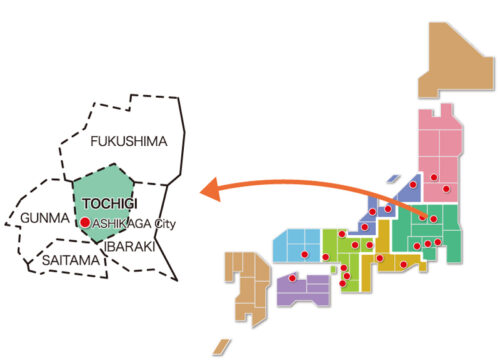Ashikaga Region

From ‘Meisen’ to a knit producing region
After producing just cotton textiles, Ashikaga City and its surrounding area in Tochigi Prefecture refocused and starting manufacturing textiles with silk after entering the Meiji Period (1868-1912). Records show its history dating back to the Nara Period (710-784), where its fabrics are said to have been presented to the Todai Temple on the occasion of the Daibutsu-Kaigen (a ceremony to consecrate the Great Buddha in 752), while reference is also made to Ashikaga textiles in the ‘Tsurezuregusa’ essays (‘Essays in Idleness’ by Kenko YOSHIDA) during the Kamakura Period (1185-1333).
As the Showa Period (1926-1989) opened, ‘Ashikaga Meisen’, referring to silks woven in a wide range of patterns with a traditional ‘Hogushi-gasuri’ technique, rose to nationwide fame. Ashikaga was listed as one of the top five Meisen producers in those days, with Isesaki, Kiryu, Chichibu and Hachioji the four other varieties. Among this selection, Ashikaga Meisen stood out for quality in particular, featuring a highly sophisticated design at a reasonable price, thanks to an efficient production system. It then made even more of a name for itself nationwide when promoted by posters from a leading painter, Shinsui Ito. After the war, as more and more Japanese people began wearing western clothes, the region developed its textile industry centring on tricots (warp knits), blending staples and filaments alongside circular knitted fabrics. Another initiative was the < Ashikaga Samurai Fiber Project >, using Sumi-zome (charcoal dyeing) and launched as part of a new promotional attempt.
